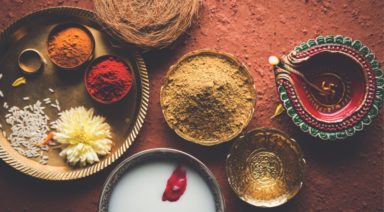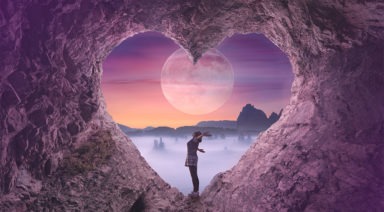Awakening to Parvati: How the Goddess Shows Up in Your Life

My First Encounter with Goddess Parvati
My most powerful encounter with the Goddess Parvati came at the tender age of 14 as my family was moving from Ohio to Colorado. We left friends, cousins grandparents, and most important to our story, my childhood love. I still feel the anguish in my heart when I recall this separation and loss.
Even today, a James Taylor song brings me back to that trek across the country where I kept my turquoise engraved necklace close to me. Can you remember your first love and the immense grief you felt when the relationship was severed? This childhood passion is at the heart of Parvati’s story. Parvati’s pure determination to reunite with Shiva is not only our longing to merge with a partner, but our desire to reunite with Spirit.
As children, we remember that first painful encounter with separation when our mother initially leaves us. The wailing tantrum ensues and no one else can suffice to soothe our aching hearts. We feel the primal urge for connection. This primordial longing to be held, cuddled, and embraced is universal to all. Without initial bonding we suffer enormously in life, always searching for this connection. We constantly feel incomplete, insufficient, and unworthiness creeps in. We search and search to be nourished, mothered, and appreciated on some level. The irony yoga teaches us is that this ultimate nourishment is already within you. It’s what you’re made of – pulsing stardust!
Honor Parvati with this ‘Surrender into Your Roots’ vinyasa!
At its depth, yoga teaches us to reunite with our essential nature; a vibration we call consciousness or the “mother energy” that holds everything together. This energy vibrates, it pulsates, and as a result, begins to heal feelings of doubt, inadequacy, fear, and unworthiness. As we learn to grow this vibratory essence through meditation we simultaneously grow our capacities and talents. Simply put, vibration heals.
This mother energy or life force the yogis called “Prana shakti,” is simply felt just below the surface of awareness as your heart beats, blood flows, and breath expands and contracts. “Prana shakti” is the life force, the power that fueled life from the big bang, to your heartbeat and every cell. Prana Shakti is the sap in a tree, the sparkle in the stars, the cycles of the moon, and the rhythms in our ocean tides. Everything is alive, pulsing, and throbbing with intelligence.
If everything is joyfully alive then why don’t we remember our lightness of being?
The Tantric tradition tells us we play “hide and go seek” with this aliveness. It’s as if humans are more like rocks when it comes to vibration. We are thick and heavy, and we just don’t remember that we radiate like the stars. We have trauma and conditioning and even lifetimes of negative patterning that inhibits our gifts from shining forth. That is until our yoga practice give us the experience of our lightness. Eventually we begin to see the power that fuels everything in you. This comes mostly through a committed meditation practice in which we tangibly tap into more and more vibration.
This essence of consciousness that is our strength and courage, nurtures and challenges us to evolve. This courageous life force we call Parvati, is the part of you that has desire and devotion to partnering in life, as well as to the mysteries of life.
Through her childhood romance, Parvati is the unwavering commitment to love. The story of Parvati’s longing for Shiva is our own human search for integration, a desire to experience both matter and spirit united.
Parvati’s Story
The world is in a dark place. The oceans are filling with plastic, red tides are killing sea life, the smoke filled air is unbreathable, and leadership/politics are corrupt. Brahma, the creator of the Universe, is worried as Shiva is deep in meditative absorption refusing to attend to the world. Brahma prays to the divine feminine, begging her to reincarnate to allure Shiva off the mountain with her beauty and sensuality. Together they will bring the necessary healing to the planet. United, they create magnetic, creative energy.
This energy of awakened consciousness (masculine and feminine united) is in every human being as talents, gifts, and capacities. Much of the time we only get a glimpse, our capacities never fully engaging our true potential, but yoga gives us the tools to uncover our doubt, fear, insecurity, and feelings of inadequacy. Instead of allowing these negatives forces to lead life, yoga shows us just how it’s possible to use our pain to make more of ourselves. Quite literally we can burn off much of our fear through meditative absorption.
Back to our story:
Goddess Parvati agrees to incarnate as the “daughter of the mountain” strong and determined, to reunite with her beloved Shiva. At the sweet age of fourteen she transports herself to the Himalayas where daily she offers intoxicating flowers and calls to Shiva, “Om Namaha Shivaya, wake up my beloved.” Unfortunately, not even Parvati can bring Shiva out of meditation. (He is still grieving his first wife Sati’s human death)
Brahma grows quite concerned that without the divine couple, the Earth will perish. He calls on Kama ( The God of Love) to shoot a “bliss” arrow into Shiva’s heart. Surely, the God of love could awaken Shiva to his worldly senses.
As Kama shoots his love arrows into Shiva’s aching heart, Shiva opens his third eye and furiously blazes fire straight into poor Kama who incinerates before everyone’s eyes. Raiti (Kama’s wife) and Parvati plead with Shiva to bring him back. After all, without Kama the world will not procreate and everything will die. Shiva agrees to bring Kama back, but without a body.
Angered by this trickery, Shiva turns back inside himself and into meditative states. Parvati, more determined than ever, decides to do yoga. She goes to the raging river, stands on one leg calling out his name, “Om Namaha Shivaya.” Eventually, Shiva softens (the love arrows penetrates deep inside) and hears her call. He decides to test her devotion by disguising himself as a Brahmin boy and tells her she is wasting her time on Shiva.
“Shiva is an outcast, dirty, and will never be a good partner,” he goes on to test her. “Shiva is a dirty sadhu living in the mountains. He is not fit to be your husband as you are so beautiful and refined. You would do better with Vishnu, who is handsome, well put together, and an erotic lover.”
Parvati angered replies, “Shiva is my beloved and no-one else will ever do. He is my one and only love.“
At this moment Shiva reveals himself to Parvati, they embrace and make love all over the cosmos bringing balance and harmony to the planet once again. The masculine and feminine reunited represent not only the embrace of our loved ones, but also the inner merging with the Divine.
Where to Find Parvati
When we step into a serious practice of meditation we begin to experience an immersion into a vibratory field, a pulsing bubble bath. It’s here we heal and grow our capacities for autonomy. By claiming autonomy, we step into our very own capacities and talents. As we enter relationships we are more whole, less needy, and more effective in life.
Parvati represents our childhood passions and desire to step into relationships, to endure and strengthen them, no matter what challenges come our way. She is devotion to partnership, but also to her inner practice of finding love and worthiness from inside herself.
We find Parvati when we dance, do yoga, and meditate. We find her in nature and very much in the mountains when we run, hike, and frolic amongst the trees, rivers, and animals. Parvati loves the challenge, the adventure, and all things that bring her strength, such as her love for Shiva and for true partnership.
We find Parvati in our pranayama practice when our inbreath pours into our outbreath, and our outbreath pours into our inbreath. The two entangle and become each other. We call this Samadhi, or meditative absorption — a moment of waking up. A deep healing occurs and eventually we gain access to more of ourselves. After all, awakening in the Tantric heart means living outrageously by offering your greatest contribution to your community. This leads to planetary upliftment.
Parvati Practices
Yoga Asana: Standing, balancing postures that build strength, focus, and agility.
POSES
- Tree pose | vrksasana
- Utthita hasta Padangusthasana, extended hand-to-big-toe pose
- Ardha chandrasana, half moon
- Parivrtta Ardha Chandrasana, revolved half moon
ACTIVITIES
- Stand in the middle of a creek on one leg in tree pose ( Vrksasana) Think of a loved one and your total devotion to loving them. Embody the Goddess Parvati with pure determination to stand for love.
- Walk, hike, run, climb in the mountains
- Commit to a yoga/ dance practice
- Devote yourself to daily meditation practice
- Go about your daily life with strength, endurance, and commitment to your relationships
- Motherhood; childcare
- Will and power to train for an athletic endeavor
- Integrating the mundane with the sacred. Light a candle before sitting down to do your finances or before creating a meal
- Pranayama: Surya Bhedana for developing strong sun energy
- Ujjayi Pranayama: Uprising of the inner light breath
Lalitha Invites Beauty and Play Through Sugarcane Pose

I’m sure at some point in your yoga journey you have unknowingly experienced Sugarcane Pose. Sugarcane pose’s English translation is rarely used. Instead, it is referred to as Ardha Chandra Chapasana, or just Chapasana. It is a standing backbend version of Half Moon Pose (Ardha Chandrasana). Ardha means ‘half,’ Chandra means ‘moon,’ Chap means ‘bow,’ and Asana means ‘pose’.
I’m half Filipina and I was lucky to have a father working for the U.S. government who was interested in working in Southeast Asia because he is Filipino, so I lived there until the age of 17. Whether we were in Taipei, Seoul, Manila or Jakarta, there would always be a street stand selling raw sugarcane.
As a result, I grew up gnawing on sugarcane husks, relishing in the flavor of the sugary sweet juice and the texture of the dense, fibrous cane. When I heard the name sugarcane pose and discovered that Lalitha was sometimes referred to as the Sugarcane Goddess, I felt very connected to both the pose and the goddess and wanted to know more.
Lalitha’s Depiction
One translation of Lalitha’s name is ‘she who plays.’ When we invite the essence of Lalitha into our lives, we are inviting spontaneity, playfulness, and joy into our lives. She is a form of Shakti Devi, the auspicious feminine energy relevant to the Universe or Source. She represents beauty, and her depiction conveys that.
Lalitha is usually seen seated on a lotus flower which guides us toward fulfilling our desires. She has long, black, gorgeous hair that smells like flowers, and a slight red tinge to her skin tone.
Her skin color is beautiful and represents the color of the first dawn or the hopefulness of new beginnings, and she is sometimes referred to as the Red Flower Goddess. She has four arms and a crescent moon adorns her forehead. In her hands, she holds a bow of sugarcane, five arrows made of flowers, a farming instrument for rounding up cattle (a goad), and a noose. The goad and noose represent our ability to develop an aversion (goad) to attachment (noose) and eventually find true joy.





































